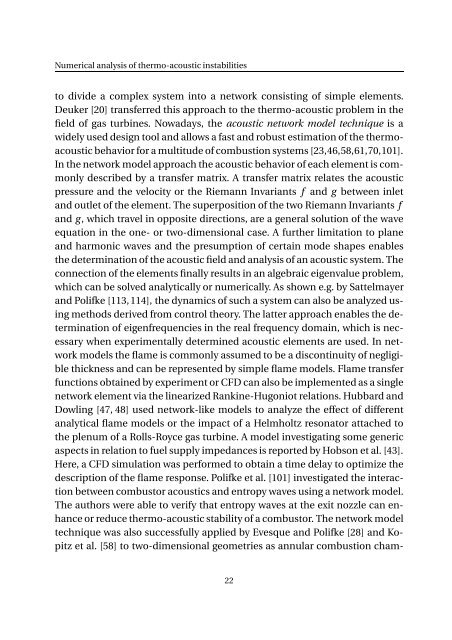Impact of fuel supply impedance and fuel staging on gas turbine ...
Impact of fuel supply impedance and fuel staging on gas turbine ...
Impact of fuel supply impedance and fuel staging on gas turbine ...
Create successful ePaper yourself
Turn your PDF publications into a flip-book with our unique Google optimized e-Paper software.
Numerical analysis <str<strong>on</strong>g>of</str<strong>on</strong>g> thermo-acoustic instabilities<br />
to divide a complex system into a network c<strong>on</strong>sisting <str<strong>on</strong>g>of</str<strong>on</strong>g> simple elements.<br />
Deuker [20] transferred this approach to the thermo-acoustic problem in the<br />
field <str<strong>on</strong>g>of</str<strong>on</strong>g> <strong>gas</strong> <strong>turbine</strong>s. Nowadays, the acoustic network model technique is a<br />
widely used design tool <str<strong>on</strong>g>and</str<strong>on</strong>g> allows a fast <str<strong>on</strong>g>and</str<strong>on</strong>g> robust estimati<strong>on</strong> <str<strong>on</strong>g>of</str<strong>on</strong>g> the thermoacoustic<br />
behavior for a multitude <str<strong>on</strong>g>of</str<strong>on</strong>g> combusti<strong>on</strong> systems [23,46,58,61,70,101].<br />
In the network model approach the acoustic behavior <str<strong>on</strong>g>of</str<strong>on</strong>g> each element is comm<strong>on</strong>ly<br />
described by a transfer matrix. A transfer matrix relates the acoustic<br />
pressure <str<strong>on</strong>g>and</str<strong>on</strong>g> the velocity or the Riemann Invariants f <str<strong>on</strong>g>and</str<strong>on</strong>g> g between inlet<br />
<str<strong>on</strong>g>and</str<strong>on</strong>g> outlet <str<strong>on</strong>g>of</str<strong>on</strong>g> the element. The superpositi<strong>on</strong> <str<strong>on</strong>g>of</str<strong>on</strong>g> the two Riemann Invariants f<br />
<str<strong>on</strong>g>and</str<strong>on</strong>g> g , which travel in opposite directi<strong>on</strong>s, are a general soluti<strong>on</strong> <str<strong>on</strong>g>of</str<strong>on</strong>g> the wave<br />
equati<strong>on</strong> in the <strong>on</strong>e- or two-dimensi<strong>on</strong>al case. A further limitati<strong>on</strong> to plane<br />
<str<strong>on</strong>g>and</str<strong>on</strong>g> harm<strong>on</strong>ic waves <str<strong>on</strong>g>and</str<strong>on</strong>g> the presumpti<strong>on</strong> <str<strong>on</strong>g>of</str<strong>on</strong>g> certain mode shapes enables<br />
the determinati<strong>on</strong> <str<strong>on</strong>g>of</str<strong>on</strong>g> the acoustic field <str<strong>on</strong>g>and</str<strong>on</strong>g> analysis <str<strong>on</strong>g>of</str<strong>on</strong>g> an acoustic system. The<br />
c<strong>on</strong>necti<strong>on</strong> <str<strong>on</strong>g>of</str<strong>on</strong>g> the elements finally results in an algebraic eigenvalue problem,<br />
which can be solved analytically or numerically. As shown e.g. by Sattelmayer<br />
<str<strong>on</strong>g>and</str<strong>on</strong>g> Polifke [113, 114], the dynamics <str<strong>on</strong>g>of</str<strong>on</strong>g> such a system can also be analyzed using<br />
methods derived from c<strong>on</strong>trol theory. The latter approach enables the determinati<strong>on</strong><br />
<str<strong>on</strong>g>of</str<strong>on</strong>g> eigenfrequencies in the real frequency domain, which is necessary<br />
when experimentally determined acoustic elements are used. In network<br />
models the flame is comm<strong>on</strong>ly assumed to be a disc<strong>on</strong>tinuity <str<strong>on</strong>g>of</str<strong>on</strong>g> negligible<br />
thickness <str<strong>on</strong>g>and</str<strong>on</strong>g> can be represented by simple flame models. Flame transfer<br />
functi<strong>on</strong>s obtained by experiment or CFD can also be implemented as a single<br />
network element via the linearized Rankine-Hug<strong>on</strong>iot relati<strong>on</strong>s. Hubbard <str<strong>on</strong>g>and</str<strong>on</strong>g><br />
Dowling [47, 48] used network-like models to analyze the effect <str<strong>on</strong>g>of</str<strong>on</strong>g> different<br />
analytical flame models or the impact <str<strong>on</strong>g>of</str<strong>on</strong>g> a Helmholtz res<strong>on</strong>ator attached to<br />
the plenum <str<strong>on</strong>g>of</str<strong>on</strong>g> a Rolls-Royce <strong>gas</strong> <strong>turbine</strong>. A model investigating some generic<br />
aspects in relati<strong>on</strong> to <str<strong>on</strong>g>fuel</str<strong>on</strong>g> <str<strong>on</strong>g>supply</str<strong>on</strong>g> <str<strong>on</strong>g>impedance</str<strong>on</strong>g>s is reported by Hobs<strong>on</strong> et al. [43].<br />
Here, a CFD simulati<strong>on</strong> was performed to obtain a time delay to optimize the<br />
descripti<strong>on</strong> <str<strong>on</strong>g>of</str<strong>on</strong>g> the flame resp<strong>on</strong>se. Polifke et al. [101] investigated the interacti<strong>on</strong><br />
between combustor acoustics <str<strong>on</strong>g>and</str<strong>on</strong>g> entropy waves using a network model.<br />
The authors were able to verify that entropy waves at the exit nozzle can enhance<br />
or reduce thermo-acoustic stability <str<strong>on</strong>g>of</str<strong>on</strong>g> a combustor. The network model<br />
technique was also successfully applied by Evesque <str<strong>on</strong>g>and</str<strong>on</strong>g> Polifke [28] <str<strong>on</strong>g>and</str<strong>on</strong>g> Kopitz<br />
et al. [58] to two-dimensi<strong>on</strong>al geometries as annular combusti<strong>on</strong> cham-<br />
22
















